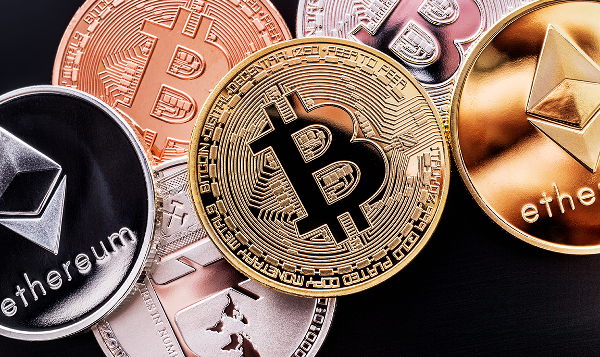Bitcoin has been worth between a fraction of a cent and more than a new car. Some people say Ethereum is even better. So, what are they?
You may have heard of Ethereum. You’ve almost certainly heard of Bitcoin. You may even have heard of people making fortunes off of them.
What you may not have heard is what exactly these two projects are.
What Are Ethereum and Bitcoin?
Ethereum and Bitcoin are two different versions of the same underlying concept called a blockchain token. Each was invented to work as a virtual currency. To understand how these two projects work and differ, you first have to understand the concepts of blockchain and virtual currency.
What Is Blockchain?
Blockchain is a form of digital data storage. In a blockchain, data are recorded on a series of digital ledgers that everyone can see; it’s called, appropriately, the “public ledger.” Permission to write any data onto this ledger is controlled through cryptography. Only someone with the right key can unlock a ledger to make any changes.
To prevent misuse, the public ledger is actually a series of databases that all store identical information. Whenever a change is made to one database, it checks its information against all copies. If the data are not consistent, and if the change doesn’t come with the cryptographic key, that change is rejected.
Enough changes to this ledger are collected into a “block” of data that can no longer be altered, and these blocks are stored in a chronological chain in the database. Hence the term “blockchain.”
Think of it like a roomful of accountants, each watching each other, each keeping the same set of books. If someone makes a change to one book it’s easy to see the problem and correct it. Only an authorized user can come into the room and give all of those accountants the proper ID to make any changes. And each time a book fills up, it gets put on the shelf next to all the others.
The core concept of blockchain is to create unique digital ownership. If the blockchain says that I own file 123ABC, then I own it. I can make as many copies of that file as I want, but the blockchain will still say that there is only one file 123ABC and I own it.
A blockchain token, then, is a digital asset created using this system. A token is simply an entry on the blockchain that has a unique identification and an owner. The security that blockchain provides makes it (so far) impossible to duplicate the entry or change its owner.
Again, think of it like our accountants. Say they created a row in their books and entitled it “Asset Five: Owner John Smith.” Asset Five would now be a token, a unique asset owned by this person. Someone could try to erase it, or change its owner or add sixteen more “Asset Fives,” but each change would be spotted and fixed.
Asset Five, whatever that is, would belong to John Smith until he decided to change that. That’s a blockchain token: The blockchain is a secured database. A token is a section of that database saying “this is a digital asset, and it belongs to this person.” The public nature of the database makes sure that no one can change ownership of that asset without permission.
What Is Virtual Currency?
Bitcoin and Ethereum are both forms of virtual currency. So what is that?
Virtual currency is simply currency that only exists online. It has no real world counterpart. Bitcoin, for example, only ever exists as numbers on a screen. The blockchain records how many exist and who owns each one, and your personal account tells you how many bitcoins you personally own. The same goes for Ethereum.
In both cases, one token amounts to one unit of the currency. In the case of Bitcoin, one token on the blockchain is one bitcoin. In the case of Ethereum, one token on the blockchain is one ether because the project Ethereum calls its currency units “ether.”
This is in contrast with traditional currencies like the U.S. dollar, which has physical notes.
If all that sounds borderline ridiculous, it’s really not that bizarre. Most of the world has run on semi-virtual currency for decades. In fact, the U.S. dollar itself is a mostly virtual currency by now.
At time of printing, the Federal Reserve measured approximately $1.7 trillion in circulating U.S. notes, but more than $3.7 trillion in liquid currency. It measures another $14 trillion in time-bound currency, money that is tied up, such as in a savings account or a time deposit. Together these two figures (officially “M1” and “M2”) make up the total money supply in the United States, and it’s more than 10 times as large as the amount of physical currency in circulation.
More than one in every 10 dollars just in America alone exists purely on a computer screen, just because a database somewhere says “this dollar exists and it belongs to Eric Reed.”
A virtual currency simply has no real world counterpart. It is a currency that exists entirely online. On the blockchain there is an entry that creates a token. That token is a single unit of currency, and it has a listed owner.
Not all that dissimilarly from how your bank works.
What Is Bitcoin?
OK! Now that we’ve covered the basics, what are Bitcoin and Ethereum?
Each of these, as you now know, is a virtual currency built using blockchain. Bitcoin was the first virtual currency. It started both that concept and the concept of blockchain itself when it was announced by an anonymous programmer who published a whitepaper under the name Satoshi Nakamoto (a little bit like publishing under the name “John Smith” in the U.S.).
Bitcoin is a pure cryptocurrency, which is to say that it does nothing else. The Bitcoin blockchain has no function other than track all the bitcoins in existence and periodically add new ones. The public ledger accounts for each token and its owner (or owners, as it’s possible to own fractions of a bitcoin), along with that token’s full history of ownership back to when it was created.
Whenever someone sells or trades their bitcoin to someone else, the ledger updates this record.
Bitcoin is modeled after gold. The algorithm behind this particular digital currency allows the blockchain to periodically make new tokens but it also has a hard limit. Once 21 million bitcoins have been added to the database, it will never add any new ones.
New bitcoins are added, appropriately enough, through what’s called “mining.” Mining is part of the cryptography process that unlocks the database so that bitcoin holders can transfer their tokens. Part of this involves solving an extremely processer-intensive series of equations.
To do this, the user sends his or her request to the Bitcoin network. Other users connected to that network operate as “miners.” Their computers set to work solving these equations. Eventually one will come up with the correct answer. This user will unlock the blockchain, review all transactions to make sure that the current one is legitimate and then update the record. In exchange, a number of new bitcoins are created.
Those bitcoins are added to the database and awarded to the user who unlocked them.
Bitcoin in a Nutshell
That’s a lot. Here are the basics:
• Bitcoin is a digital currency based on blockchain.
• It is a pure currency, it doesn’t do anything else. The only purposes of a bitcoin token are to save it or spend it.
• It works by having other users on the Bitcoin network check the record of transactions to confirm each new transaction.
• It is modeled after digital gold. The number of bitcoins in circulation grows slowly and will someday cap out at 21 million.
What Is Ethereum?
So that’s Bitcoin, the digital currency that drove people so mad that they spent $20,000 just to not actually get their hands on one. Now, what’s Ethereum?
Glad you asked. Ethereum is in some ways more advanced than its predecessor.
Ethereum is the name of a project that runs the Ethereum network. The actual digital currency that this network uses is called ether. Now, you can buy, sell and spend ether just like any other digital currency. Plenty of users do. But the key to understanding Ethereum’s bigger picture is this: Like any database, you can enter more or less anything onto a blockchain network. This includes actual computer code itself.
For all its advances, blockchain is ultimately a form of data storage. This lets programmers use it to store data for local applications, or to write scripts directly to sections of the blockchain database and execute them from within it. Although this is not quite right, think of it like plugging formulas and scripts into cells on an Excel spreadsheet. You can write the code directly into the database and, because Excel is built to recognize and execute that script, it will perform the operation.
Ethereum takes advantage of this to do two things. The first is called Decentralized Apps, or “dApps.” They are beyond the scope of this article, but essentially dApps are programs that write their data to and from a blockchain instead of local sources like your hard drive.
The bigger point of Ethereum is that it creates what are called “Smart Contracts.” These are self-executing contracts that take in data, execute orders and move money around automatically. That idea has a lot of people in the business and financial world very excited.
Here’s how it works: Let’s say John orders a pizza from Susie and agrees to pay her $20. In the real world, Susie makes the pie, delivers it to John’s door and hopes that he has the money. Or John pays in advance, then hopes that Susie will actually make the pie and deliver it to his door.
A smart contract could act as a middleman in this transaction. John and Susie would create their contract. Twenty dollars’ worth of ether (the currency used on this network) would go into escrow pending completion of the contract. Then Susie would deliver her pie, they would confirm delivery and the money would be released into Susie’s account.
This might seem trite in the context of pizza delivery, but think about it in the form of an Amazon package. Let’s say you pay $100 for two dozen Papa Smurf hats (we don’t judge here). Instead of having that money go directly to the seller, it would wait in escrow until Amazon’s delivery team digitally confirms delivery of the package, at which point payment would happen automatically.
This form of self-executing contract is not something that Bitcoin can offer.
Ethereum in a Nutshell
Again, that was a lot. Here are the basics:
• Like Bitcoin, Ethereum is a digital currency built on a blockchain network.
• Ethereum is the name of the project and network, ether is the name of the currency.
• Ether can be traded, bought, sold and spent just like any other currency.
• Ethereum was not created as a pure digital currency. It was built as a platform for smart contracts and applications using a blockchain network.
• Ether is the currency used for Ethereum’s smart contracts and applications.
Read more at: https://www.thestreet.com/technology/bitcoin-vs-ethereum-14877486







